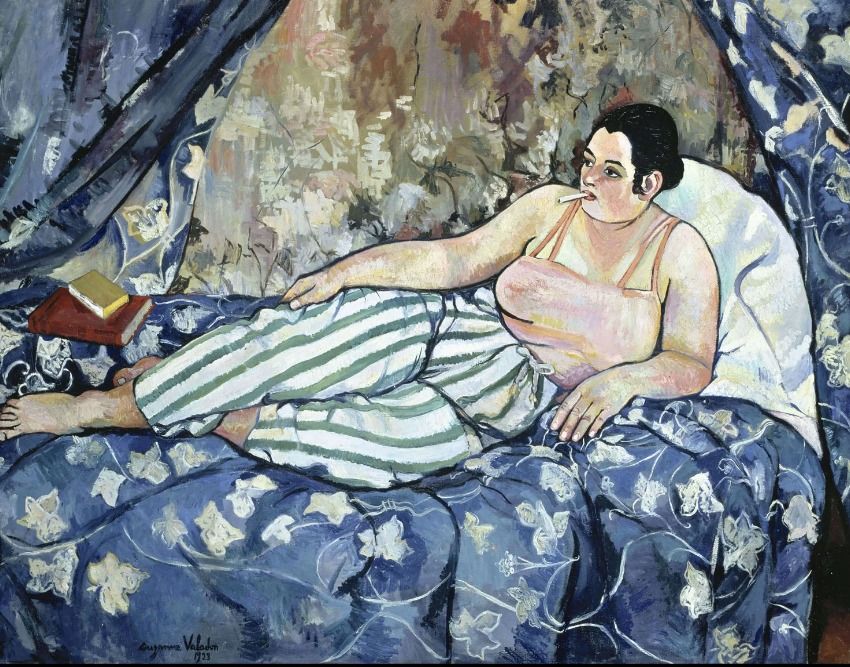Barcelona, 04/23/2024
Born in Bessines-sur-Gartempe, a small town in central France, in 1865 and into a less privileged family, Suzanne Valadon (originally called Marie-Clémentine) ended up in Montmartre in her childhood, when this Parisian neighborhood was emerging. as a mecca for artists of very varied origins, and in addition to carrying out different trades, he was a model for a good number of creators, whom he therefore saw working very closely before embarking on his own self-taught career, in a process that, in his circumstances and at that moment, it was very epic.
That’s the title, “Suzanne Valadon. A modern epic”, from the exhibition that the National Museum of Art of Catalonia offers until next September in collaboration with the Center Pompidou-Metz and the Musée d’Arts of Nantes, under the curator of Eduard Vallès, head of Collections from the MNAC, and Philip Dennis Cate, independent curator. Conceived as an anthology, his first in Spain, it brings together more than a hundred pieces including oil paintings on canvas and cardboard, drawings and engravings, sculptures in plaster and bronze and documentary material designed to bring us closer to Valadon’s personal journey and the context of Paris. avant-garde in which he developed, rubbing shoulders with authors such as Matisse or Degas and the Catalans Casas, Rusiñol and Miquel Utrillo; The latter would also be her partner and would assume paternity of her son, the future painter Maurice Utrillo. They portrayed each other on several occasions (perhaps the most famous, a Utrillo poster for Théâtre d’Ombres Parisiennes in which she appears) and her relationship, although tempestuous and intermittent, lasted just over a decade.
He was not, as we said, the only one to bring her to his compositions: he posed for Puvis de Chavannes, Renoir, Toulouse-Lautrec, André Utter, Steinlen or Rusiñol, and Degas referred to his personality as terrible, alluding to the strong character she would have to display to make her way (in fairness, it was also he who encouraged her to follow her own path in painting). She would also be the muse for a large number of posters like that of Utrillo at a time when these were spread across the walls of Paris and the big cities, mostly starring women, sometimes real and other times stereotyped. The MNAC preserves many of them in its Cabinet of Drawings, Engravings and Posters.
Chronicler of his life and times between the end of the 19th century and the run-up to World War II, he approached different avant-garde movements without completely ascribing to any of them and began drawing and engraving on his own when he was still working as model (his oil paintings would arrive later). Most of these compositions correspond to scenes of toilets and a certain intimacy, clearly in line with those of the aforementioned Degas, whose death in 1917 was a blow for her.
An entire section of this retrospective at the Museu Nacional focuses on her self-portraits, usually interpreted, more so in the case of women artists of this time, as an exercise in self-affirmation. After having been a model on multiple occasions, they provided Valadon with the opportunity to appropriate her own image: she created them in oil, pastel and pencil and, in some cases, in the frame of family group portraits. It is not the most numerous set of her works, but it does allow us to get closer to her self-perception from youth to old age.
Those intimate female scenes with which he had begun his production, linked to domestic and closed settings and in which male figures did not appear, would have greater validity throughout his career. He captured women alone or in pairs, in atmospheres of calm and complicity, chatting or carrying out some activity: this genre allowed him to experiment in his framing and perspectives (the latter, sometimes, effective because they were elevated) and in his chromatic palette. , lively and personal, but also flattering of lyricism.
Among his portraits, as we said, his most cultivated genre, although he also created still lifes or landscapes, some of his partners and family members and others of more or less famous personalities, critics and collectors have met in Barcelona, which he would create by commission or commitment. ; The latter would come to testify to the professional and social prestige acquired by Valadon. Although we find in them features of isms that were contemporary to them, they also had their own stamp: colors that attracted the eye and thick profiles.
One of those portrayed by the artist was the musician Erik Satie, with whom she had a brief relationship, lasting about six months, in 1893; He kept this fabric throughout her life and it seems that it was to her, his only known partner, to whom he gave his famous Vexations. The person who also painted this composer, in front of the Moulin de la Galette, in gray tones and when he had not yet acquired international fame, was Ramón Casas; That painting is preserved in the Northwestern University Library, and two of his preparatory drawings are in the Barcelona museum. Due to its symbolism and quality, it is perhaps the best portrait of Satie.
The exhibition ends with his nudes, the subject in which he delved the most in his stage of maturity, in terms of number of pieces and the compositional experimentation (in postures and perspectives) that this subject allowed him. This type of images, of more or less explicit sexuality, were common at this time, but their creators were very rarely, as is known, women: those of Valadon draw our attention for their naturalness and their distance from stereotypes, probably traits linked to the fact that the author herself had been, in her beginnings, in the position of her models.

We find his odalisques especially ambitious, reclining on divans or sofas, with a sensuality and decorative sense that clearly refer to orientalism and the exuberance of some canvases by Pierre Bonnard or Matisse. As in his drawings and engravings, and seeking contrast of textures, he alternated clothed and naked figures. Strikingly, the most common genre among women artists of her time, that of still life, was not addressed by Valadon before its consolidation, in the 1910s and 1920s, although these regularly appeared as the background of her portraits and nudes evoking the vibrant chromaticism of Fauvism or Van Gogh.
In any case, this author received recognition during her lifetime, a rare event among artists at the beginning of the century, and the French State acquired her first work as early as 1924. It would be after her death in 1938 (Picasso and Braque attended to his burial) when he would fall into a certain oblivion, until his recovery some decades later. Her remains rest in Montmartre, the place where she achieved her achievements with determination and which also owes part of her legend to her.

“Suzanne Valadon. A modern epic
NATIONAL D´ART MUSEUM OF CATALONIA. MNAC
Palau Nacional, Parc de Montjuïc
Barcelona
From April 19 to September 1, 2024
OTHER NEWS IN MASDEARTE:









